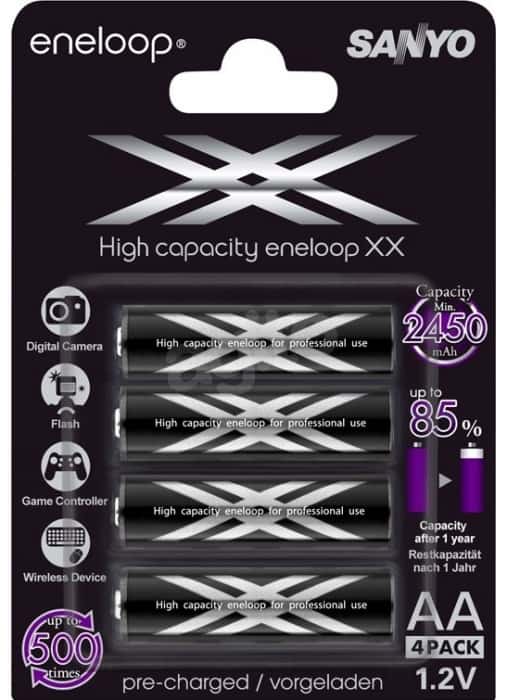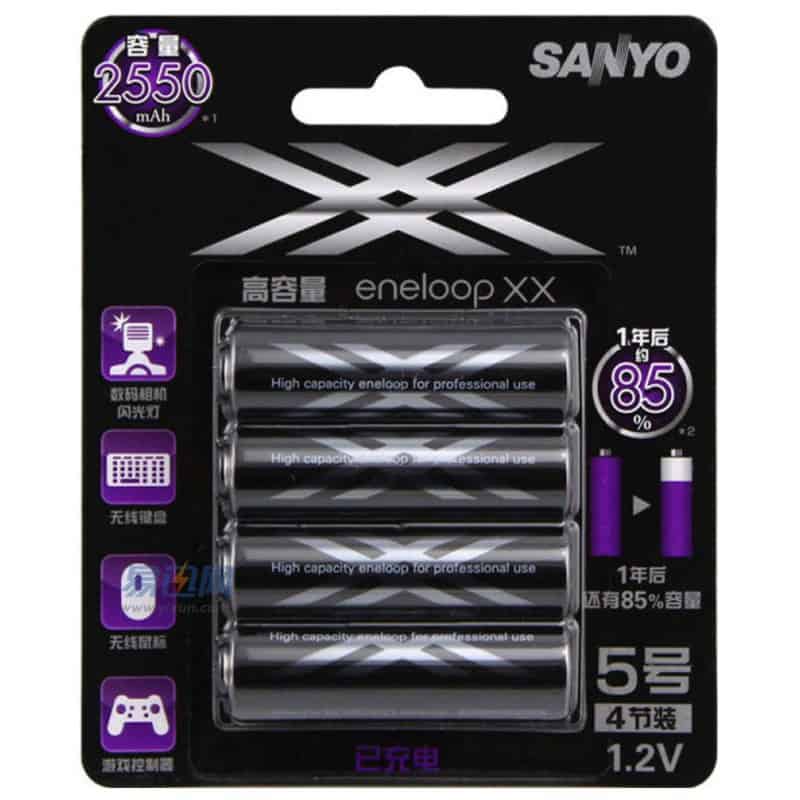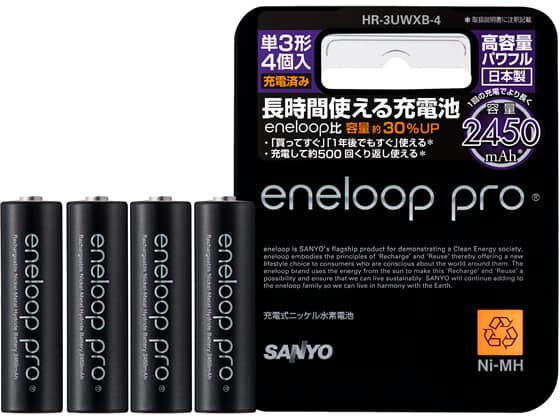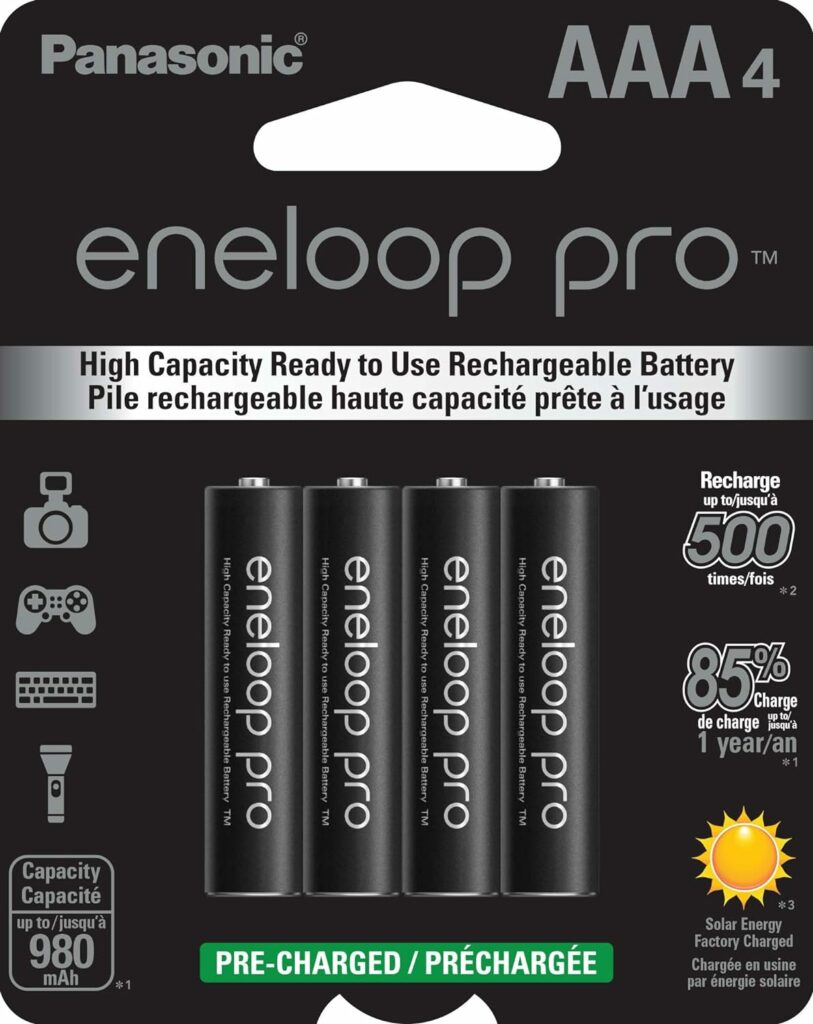Eneloop PRO
The high capacity Eneloop batteries
Eneloop XX batteries ( PRO )
Eneloop PRO batteries are one of the most powerful NiMH batteries on the market. Continue reading to know more about their strength, and weaknesses. Also, check out the differences between Eneloop vs Eneloop PRO.
A brief history of the Eneloop PRO batteries:
In 2011, Sanyo announced its first high-capacity battery, the Eneloop XX. This was a welcome announcement because Eneloop had been on the market for nearly six years (since November 2015), and only included the standard Eneloops with 1900mAh capacity. (The ones with the white wrappers).
Then came the Eneloop XX batteries. Eneloop XX were first available to the North American and European markets. However, when they finally became available to the Japanese market, Sanyo didn’t name them Eneloop XX, but Eneloop PRO.
Some facts:
- Eneloop PRO batteries are made in Japan. If you see a package saying otherwise, they are counterfeit.
- No Eneloop PRO batteries were ever made in China, not now, nor in the past!
- Eneloop PRO is only available in AA and AAA size
- There are no C or D-sized Eneloop PRO batteries
- Beware, there are still many sellers worldwide, selling fake Eneloop PRO batteries
Buy Eneloop PRO?
Check out the following page to see where to buy Eneloop PRO batteries
Sanyo Eneloop XX / Pro 1st – 5th generation.
Quick overview in chronological order
2011: 1st generation Eneloop XX
The first generation Eneloop XX was only available in AA size as of 2011. There were no AAA-sized Eneloop PRO batteries during their initial launch. (At least not under the Eneloop branding.) The product code for the 1st Eneloop Pro was: HR-3UWX and claimed a maximum of 500 recharge cycles and a minimum of 2400mAh. You can find the product specifications here. ![]()
2012: 2nd generation Eneloop PRO
Eneloop XX batteries sold in China in 2012 had a different product code, as can be seen in this Chinese Announcement. These batteries received the product code HR-3UWXA. Although the additional letter A could have indicated a new design or product (as this was the standard way Sanyo reported a new generation), the specifications stayed the same.
It’s interesting to note that these batteries had never been available in Japan with that particular product code. It looks like they were only available in China.
2012: 3rd generation Eneloop PRO
The same year Sanyo announced their first high-capacity AAA Eneloop batteries, with a minimum of 900mAh and still rated for 500 cycles and an 85% charge left after one year.
Some explanation about: 85% charge left after 1 year
This means that when the battery is fully charged, you can keep the battery untouched and the self-discharge rate would only be about 15% in 1 year. More info on charging can be found in our Ultimate Eneloop Charge Guide.
The AA batteries also received an update and now powered a minimum of 2450mAh, with the same cycle life of 500. Take a look at the Specification of the Eneloop AAA PRO, called HR-4UWXB. And the product specifications of the AA PRO HR-3UWXB.
Below you can see the different packaging for Eneloop XX… The Japanese market called them Eneloop PRO from the beginning.



2013: 4th generation Eneloop PRO
In 2013 Panasonic announced a redesign of the Sanyo-branded Eneloops. In Japan, this led to the removal of the large Eneloop logo, and to be replaced with a large Panasonic logo. Right underneath the Panasonic logo is the following text printed: eneloop rechargeable battery. The product codes changed from HR-3UWX to BK-3HCC for the AA batteries and BK-4HCC for the AAA batteries. In Europe, they are called BK-3HCCE and BK-4HCCE, respectively.
The 4th generation AA PRO specifications and the 4th generation AAA PRO batteries.
2015: 5th generation Eneloop PRO
Finally, the 5th generation Eneloops were produced, with a minimum capacity of 930mAh for the Eneloop PRO AAA and 2500mAh for the Eneloop PRO AA.
Beware that each market shows a different ‘type of capacity’. In Japan, Panasonic stopped showing the Rated capacity many years ago and instead shows the Minimum capacity. If you want to know more about how these kinds of capacity tests are done, check out the Advanced Charge section on this website.
The newest product codes are now BK-3HCD (E) for the AA Eneloop PRO, and BK-4HCD(E) for the AAA Eneloop PRO.
2024: North America 5th generation Eneloop PRO: 2600mAh and 980mAh
North America is using rated capacity, which might confuse people. These are the same 5th generation Eneloop Pro batteries, but using rated capacity instead of minimum capacity like they do in Europe and Japan.
The product names for AAA: BK4HCCA
The product name for AA: BK3HCCA


How to charge Eneloop PRO batteries?
The best way to charge an Eneloop Pro battery is with a smart battery charger. The battery charger will charge till it notices a small drop in voltage, which means the battery is full. These chargers can be seen in the Advanced Chargers overview on this site. Panasonic also has a few smart Eneloop chargers in their lineup, and few are sold specifically with Eneloop PRO batteries, like the Panasonic BQ-CC55.
- If you can set the charge rate (in mA), you should set them between 1000 and 2500mA for AA PRO and about 450-900mA for AAA PRO.
- This is the recommended charge rate of .5C – 1C.
- Read more about that in our Eneloop charge guide.
Eneloop vs. Eneloop PRO
The short answer: the Eneloop Pro battery has a higher capacity than the regular Eneloop with 2500mAh vs. 1900mAh. The Pro can be charged up to 500 times while the regular Eneloop up to 2100 times. The PRO batteries can provide more current than the regular Eneloops.
There are a few questions you need to answer for this:
- What am I going to use the batteries for?
- How often will I recharge them?
- Do I really need maximum capacity?
- How far will I discharge them?
- What charger do I have and use?
Eneloop PRO AA Pros and Cons
By answering those questions, you can decide which type of battery is right for you. Generally speaking, Eneloop PRO batteries are more fragile. And that’s common for high-capacity rechargeable NiMH batteries. The internal resistance increases quicker than with regular Eneloops, and therefore has a shorter life cycle.
Good and bad:
- The Eneloop PRO is excellent for Camera flashes, flashlights, etc. When you need maximum power or maximum battery life with a high-drain application, this is the battery to get. Inside camera flashes, Eneloop PRO also recycles the flash faster and can, therefore, pop more bursts in a shorter time!
- Eneloop PRO is excellent for longer battery life in flashlights as well. The capacity of 4 Eneloop Pro AAs is about 25% more than 4 regular AA Eneloops.
- If you only have a time-based charger, you shouldn’t buy Eneloop PRO batteries. First of all, because the timer duration will likely be set too short, the batteries won’t be fully charged. Secondly, if the batteries are still half full, the charger won’t stop until the timer has cut the charge. This means that the batteries are charged too long, and likely caused some damage.
- The Eneloop PRO is NEVER suitable for applications where batteries are continually charged, like in DECT phones. DECT phones stand on charging docks for a very long time. (These types of charge docks use something called a “trickle charge,” but in reality, it is nothing more than a continuous charge of the batteries, which Eneloop PRO don’t like).
- I don’t recommend Eneloop PROs for applications with multiple cells that drain the batteries completely. With the focus on draining completely. If you drain all batteries completely, the weakest battery gets hurt the most. Every time this happens, the weakest battery gets weaker and weaker. Eneloop PROs are more fragile and die faster than regular Eneloops.
- Eneloop PRO batteries are not recommended in very low-drain devices such as clocks. The main reason is their higher self-discharge rate. It is much more economical to use Eneloop Lite or standard Eneloops in that case. In 1 of my personal tests, I had Eneloop AA (standard) batteries ran a clock for almost 2 years straight, while Eneloop AA Lite ran it for 1 year.
- The diameter of Pro batteries is larger than regular Eneloops and, therefore, can be a very tight fit in certain devices. So if your standard white Eneloops are a tight fit, don’t get the Eneloop Pro.
Standard Eneloop AA ,AAA
- Standard Eneloops have a longer cycle life, 2100 cycles vs. 500 cycles for the Eneloop PRO.
- Standard Eneloops have a longer shelf life. They only lose 30% of their charge in 10 years, while the PRO batteries lose 15% in 1 year.
- Standard AA and AAA’s are a good fit for many applications, powerful enough for high drain devices and strong enough to handle some trickle charge and a deep discharge.
- The standard Eneloops are always good to have. They are just great batteries overall with a high life expectancy, powerful, and low self-discharge.
- Con for a standard Eneloop is less mAh compared to the Pro and less powerful, meaning that the PRO can provide more energy in a shorter amount of time compared to the standards.
Are IKEA batteries Eneloops?
That is an interesting question. Please take a look at the Rewrapped Eneloops page. You can see that Sanyo and FDK (a company that now owns the factory) sell/sold batteries to other brands. Kind of like a “white label” service. A few of them are Sony, Nikon, Canon, Duracell, etc. The IKEA ones were known to be made in Japan since 2016! Although most people only know about them since the end of 2017/ beginning of 2018. Eneloop freaks like myself know that the factory sells to other brands and have known that for many years.
So the grey IKEA batteries currently being sold come from the same factory and have almost the same specs. Unfortunately, they don’t show all the detailed specifications.
Since 2022 IKEA replaced the White and Tan versions with grey-colored batteries. While the White and Tan batteries represented PRO and LITE Eneloops, the new grey version are likely 1st gen standard Eneloops and Eneloop PRO. Note, that the tan versions were starting to be made in China. Fortunately, the new grey ones are made in Japan again.
Eneloop PRO Test
How many years do Eneloops last?
Regular Eneloops can last for 10+ years. See all the tests we provided here. Eneloop PRO can last a couple of years as well but are more sensitive. The longest-lasting Eneloops are therefore the regular Eneloops.
Camera Flash Pop Test
Eneloop PROs are one of the Highest Capacity LSD batteries on the market. I referred to other tests on the Eneloop tests page, but here I focus mainly on the Eneloop Pros test.
The first test is a Digital Camera Flash pop test. Done by member Sys at photographyonthenet website.
The following results are interesting none the less. The Powerex 2700Pro is also made in Japan, and is to my understanding the equivalent to the all famous Sanyo 2700 and now called Panasonic 2700 (Evolta).
This is the total amount of pops the flash could make on a set of batteries. This is the average between 2 flash units.. according to Sys.
- Powerex 2700 Pro:Average: 400.5
- Eneloop 2450 Pro: Average: 386.5
- Powerex 2600: Average: 380.5
- Powerex 2700: Average: 371.5
- Amazon Basics 2400Average: 359.5
- EBL 2800: Average: 331.5 7
- Duracell 2450: Average: 297.5
- Eneloop White 1900:Average: 294.5
The next test was related to the time the Flash needed to recover and flash again.. also called the recycle time. The first shows the recycle time after the first 5 pops.
- Powerex 2700 mAh Pro @ 1.48 sec
- Amazon Basics 2400 mAh @ 1.58 sec
- Eneloop 2450 mAh Pro @ 1.64 sec
- Eneloop White 1900 mAh @ 1.68 sec
- Powerex 2700 mAh @ 1.70 sec
- Duracell 2450 mAh @ 1.78 sec
- EBL 2800 mAh @ 1.81 sec
- Powerex 2600 mah @ 1.84 sec
Then the list at the 300th pop.
- Eneloop 2450 mAh Pro @ 2.5 sec
- Powerex 2700 mAh Pro @ 2.7 sec
- Powerex 2600 mAh @ 2.9 sec
- Amazon Basics 2400 mAh @ 3.5 sec
- Eneloop White 1900 mAh @ 3.6 sec
- EBL 2800 mAh @ 4.2 sec
- Powerex 2700 mAh @ 5.8 sec
- Duracell 2450 mAh @ 10.2 sec
And at last, the recycle time at the 400th pop (only the ones that made it that far).
- Eneloop 2450 mAh Pro @ 3.2 sec
- Powerex 2700 mAh Pro @ 3.6 sec
- Powerex 2600 mAh @ 4.7 sec
- Powerex 2700 mAh @ 6.2 sec
Eneloop Capacity:
Eneloop Pro 4th generation capacity results, tested by HKJ:
/Eneloop%20AA%20BK-3HCC%202450mAh%20(Black)-info.png)
0.5A = 2430mAh
1A = 2401mAh
5A= 2286mAh
This means that even at 5 Amps the batteries can still deliver 2286mAh.. which is pretty good!
For the complete test by HKJ see here.
Where to buy Eneloop PRO?
Check out the Eneloop seller’s page for the best deals. Please beware that you shouldn’t buy them from eBay… unless you know enough about Eneloops to know what to look out for. Check out the counterfeit Eneloops page to check out the differences between real vs fake Eneloops.



